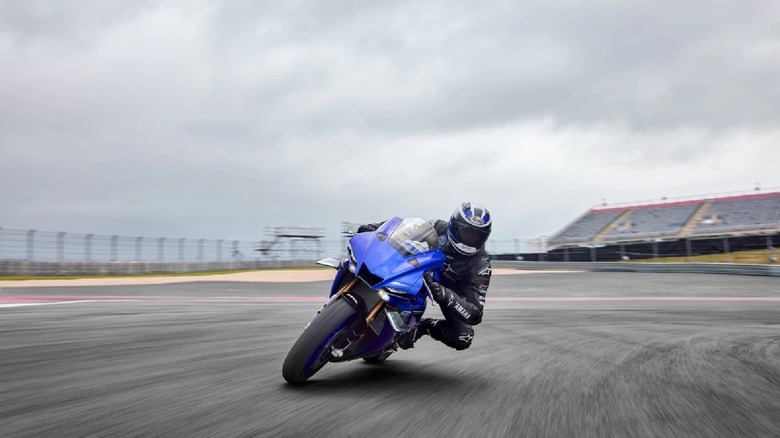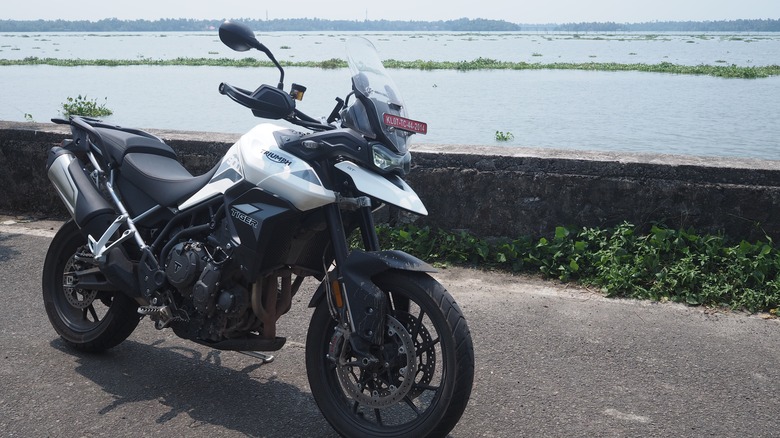What Are Clip-On Motorcycle Handlebars And Are They Better Than Regular Handlebars?
We may receive a commission on purchases made from links.
The phrase "clip-on handlebars" might sound a bit concerning, since it seems to imply that they're mounted using clips rather than something more secure. Fortunately, it's not an entirely accurate name. They don't simply clip on, but instead, this handlebar type installs directly to the fork tube using powerful attachments that won't pop off while you're on the road. The namesake is simply a way to distinguish this handlebar type from "wide" handlebars, which come as a single piece that almost always mounts above the front fork, and, more specifically, onto the triple tree and welded on with brackets.
Clip-on handlebars are most commonly found on speedy sportbikes, like the 2024 MV Agusta Brutale 1000 RS, though you may also find them on cruisers, standard motorcycles, and even the less-common motorcycle type, the café racer. What's unique about clip-ons is that they come in two pieces, with each handle requiring its own installation. And because each handle must be fitted individually, you have to make sure that they're perfectly centered and equidistant from the middle of the fork tube. Otherwise, you could end up with wobbly, uneven steering. Luckily, clip-ons are far easier to calibrate and adjust compared to other handlebar types, since they don't need to be welded on. Instead, you can simply re-adjust their position to ensure they're well-centered.
Because clip-on handlebars are installed directly to the fork tube, they result in a more "aggressive" riding position, one in which you have to lean forward to reach. This isn't to say that they're less reliable or less dependable, but they almost always demand a greater need to maintain an upright, forward-leaning position. This forward, active position can be expected for sportbikes, so they're typically ideal for intermediate and advanced riders.
Advantages and disadvantages of clip-on handlebars
Clip-on handlebars aren't inferior to your standard handlebars, but they have some caveats worth highlighting. For one, clip-on handlebars are almost always shorter, demanding the rider to lean forward and maintain a more "aggressive" riding position. In other words, the long, wide, "fused and chiseled" handlebars that you might find on a kitted-out Harley Davidson, for example, demonstrate the polar opposite of clip-ons. With clip-ons, you can expect to sit upright and forward, with a much closer and forward-leaning position that proves this handlebar type's strength among sportbikes.
Some riders might find this "aggressive" position uncomfortable, while others may prefer its improved aerodynamics and tighter handling on turns. After all, when your handlebars are situated directly above the front wheel, they make turns around tight corners much more sensitive and responsive. It's not a problem, but it's certainly something worth keeping in mind for inexperienced riders.
There are some undeniable benefits to clip-on handlebars, as well. Because this type of handlebar is most commonly found on sportbikes, you can rightly assume that it's the preferred component for customization projects. You can easily install various clip-on handlebars if your bike is compatible, and adjustments are easy as well. Here's an example of some cheap and widely compatible clip-on handlebars.
All that being said, clip-on handlebars are generally best suited for intermediate and expert motorcyclists. Their sensitive handling places them in the realm of experienced riders, while new learners are better off with the standard handlebars that you'll often find in lists of the best motorcycles for beginners. Overall, however, every motorcyclist is different, and should a newbie prefer the aggressive riding style that comes with clip-on handlebars, there's no reason to shy away.

